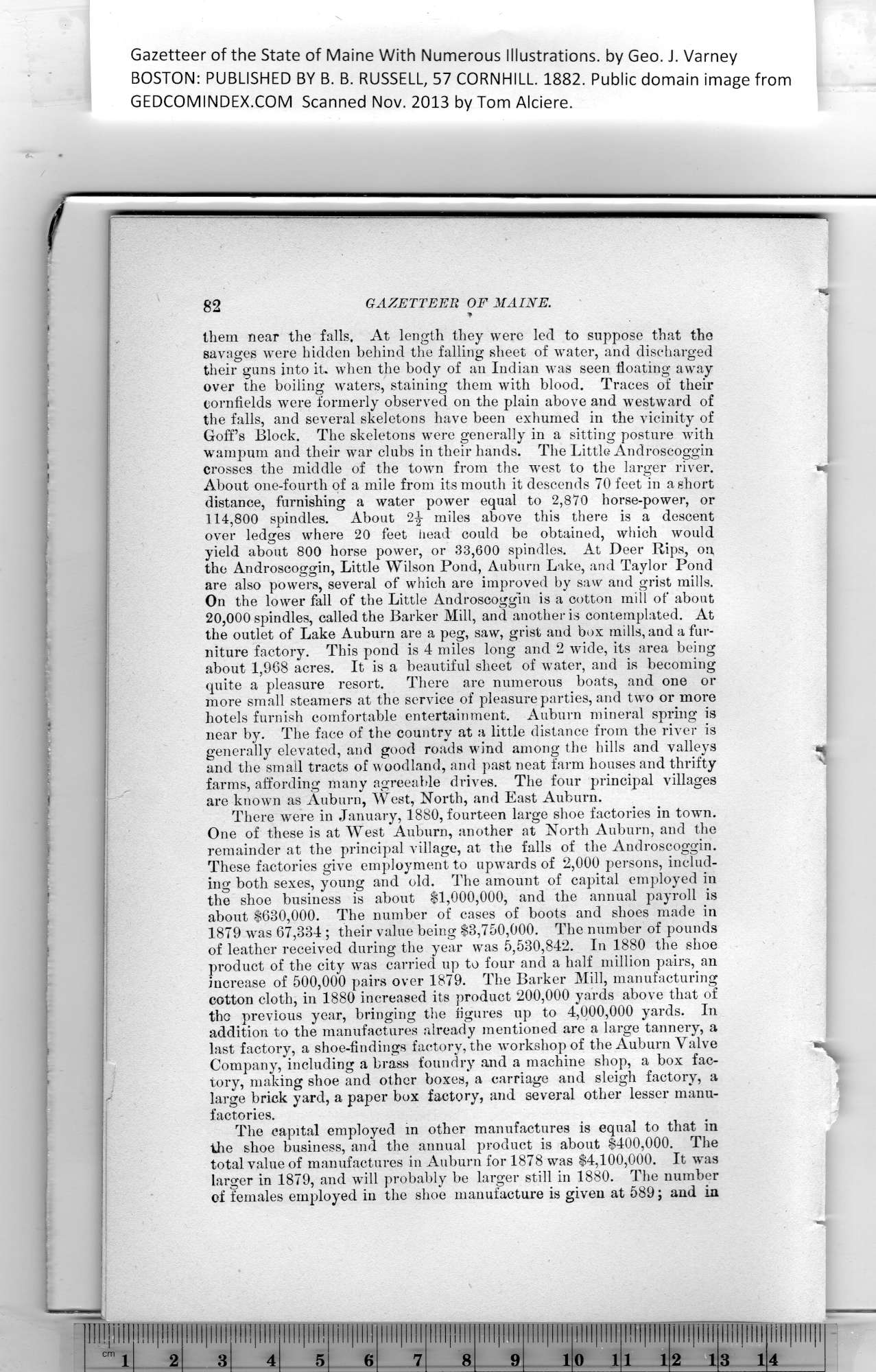|
Gazetteer of the State of Maine With Numerous Illustrations, by Geo. J. Varney
BOSTON: PUBLISHED BY B. B. RUSSELL, 57 CORNHILL. 1882. Public domain image from
82 GAZETTEER OF MAINE.
them near the falls. At length they were led to suppose that the
savages were hidden behind the falling sheet of water, and discharged
their guns into it. when the body of an Indian was seen floating away
over the boiling waters, staining them with blood. Traces of their
cornfields were formerly observed on the plain above and westward of
the falls, and several skeletons have been exhumed in the vicinity of
Goff’s Block. The skeletons were generally in a sitting posture with
wampum and their war clubs in their hands. The Little Androscoggin
crosses the middle of the town from the W'est to the larger river.
About one-fourth of a mile from its mouth it descends 70 feet in a short
distance, furnishing a water power equal to 2,870 horse-power, or
114,800 spindles. About 2\ miles above this there is a descent
over ledges where 20 feet head could be obtained, which would
yield about 800 horse power, or 33,600 spindles. At Deer Rips, on
the Androscoggin, Little Wilson Pond, Auburn Lake, and Taylor Pond
are also powers, several of which are improved by saw and grist mills.
On the lower fall of the Little Androscoggin is a cotton mill of about
20,000 spindles, called the Barker Mill, and another is contemplated. At
the outlet of Lake Auburn are a peg, saw, grist and box mills, and a fur-
niture factory. This pond is 4 miles long and 2 wide, its area being
about 1,968 acres. It is a beautiful sheet of water, and is becoming
quite a pleasure resort. There are numerous boats, and one or
more small steamers at the service of pleasure parties, and two or more
hotels furnish comfortable entertainment. Auburn mineral spring is
near by. The face of the country at a little distance from the river is
generally elevated, and good roads wind among tbe bills and valleys
and tbe small tracts of woodland, and past neat farm houses aud thrifty
farms, affording many agreeable drives. The four principal villages
are known as Auburn, West, North, and East Auburn.
There were in January, 1880, fourteen large shoe factories in towm.
One of these is at West Auburn, another at North Auburn, and the
remainder at the principal village, at the falls of the Androscoggin.
These factories give employment to upwards of 2,000 persons, includ-
ing both sexes, young and old. The amount of capital employed in
the shoe business is about $1,000,000, and the annual payroll js
about $680,000. The number of cases of boots and shoes made in
1879 was 67,334 ; their value being $3,750,000. Tbe number of pounds
of leather received during the year was 5,530,842. In 1880 the shoe
product of the city was carried up to four and a half million pairs, an
increase of 500,000 pairs over 1879. The Barker Mill, manufacturing
cotton cloth, in 1880 increased its product 200,000 yards above that of
the previous year, bringing the figures up to 4,000,000 yards. In
addition to the manufactures already mentioned are a large tannery, a
last factory, a shoe-findings factory, the workshop of the Auburn Valve
Company, including a brass foundry and a machine shop, a box fac-
tory, making shoe and other boxes, a carriage and sleigh factory, a
large brick yard, a paper box factory, and several other lesser manu-
factories.
The capital employed in other manufactures is equal to that in
the shoe business, and the annual product is about $400,000. The
total value of manufactures in Auburn for 1878 was $4,100,000. It was
larger in 1879, and will probably be larger still in 1880. The number
of females employed in the shoe manufacture is given at 589; and in
PREVIOUS PAGE ... NEXT PAGE
This page was written in HTML using a program written in Python 3.2
|
